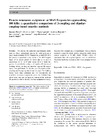Protein resonance assignment at MAS frequencies approaching 100 kHz: a quantitative comparison of J-coupling and dipolar-coupling-based transfer methods
Abstract
We discuss the optimum experimental conditions to obtain assignment spectra for solid proteins at magic-angle spinning (MAS) frequencies around 100 kHz. We present a systematic examination of the MAS dependence of the amide proton T 2′ times and a site-specific comparison of T 2′ at 93 kHz versus 60 kHz MAS frequency. A quantitative analysis of transfer efficiencies of building blocks, as they are used for typical 3D experiments, was performed. To do this, we compared dipolar-coupling and J-coupling based transfer steps. The building blocks were then combined into 3D experiments for sequential resonance assignment, where we evaluated signal-to-noise ratio and information content of the different 3D spectra in order to identify the best assignment strategy. Based on this comparison, six experiments were selected to optimally assign the model protein ubiquitin, solely using spectra acquired at 93 kHz MAS. Within 3 days of instrument time, the required spectra were recorded from which the backbone resonances have been assigned to over 96 %. Show more
Permanent link
https://doi.org/10.3929/ethz-b-000103616Publication status
publishedExternal links
Journal / series
Journal of Biomolecular NMRVolume
Pages / Article No.
Publisher
SpringerSubject
Assignment; MAS; Solid-state NMROrganisational unit
03496 - Meier, Beat H. (emeritus) / Meier, Beat H. (emeritus)
08829 - Ernst, Matthias (Tit.-Prof.)
Notes
It was possible to publish this article open access thanks to a Swiss National Licence with the publisher.More
Show all metadata

